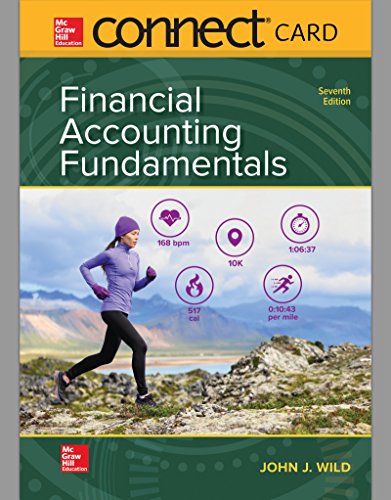
Concept explainers
1.
Compute the gross margin ratio (both with and without services revenue) and profit margin ratio.
1.
Explanation of Solution
Gross margin ratio: The percentage of gross profit generated by every dollar of net sales is referred to as gross profit percentage. This ratio measures the profitability of a company by quantifying the amount of income earned from sales revenue generated after cost of goods sold are paid. The higher the ratio, the more ability to cover operating expenses. It is computed by the formula:
Compute gross margin ratio and profit margin ratio of Company BS.
| Gross profit | Without service revenue | Total revenue |
| Revenues (A) | $18,693 | $44,000 |
| Less: Cost of goods sold (B) | ($14,052) | ($14,052) |
| Gross margin (C) | $4,641 | $29,948 |
| Gross margin ratio (D) | 24.8% | 68.1% |
Table (1)
Profit margin ratio: It is one of the profitability ratios. Profit margin ratio is used to measure the percentage of net income that is being generated per dollar of revenue or sales.
Determine the profit margin ratio of Company BS.
As per table (1) the gross margin ratio of Company BS without service revenue and with (total) service revenue is 24.8% and 68.1% respectively and the profit margin ratio of Company BS is 42.8%.
2.
Compute the
2.
Explanation of Solution
Current ratio: Current ratio is one of the
Acid test ratio: It is a ratio used to determine a company’s ability to pay back its current liabilities by liquid assets that are current assets except inventory and prepaid expenses.
Determine the current ratio and acid-test ratio of Company BS.
| Ratios | Amount | Result |
| Current ratio | ||
| Current assets (A) | $95,568 | |
| Current liabilities (B) | $875 | |
| Current ratio | 109.2:1 | |
| Acid-test ratio | ||
| Quick assets (C) | $90,924 | |
| Current liabilities (D) | $875 | |
| Acid-test ratio | 103.9:1 | |
Table (2)
The current ratio and acid-test ratio of Company BS is 109.2 and 103.9 respectively.
3.
Compute debt ratio and equity ratio.
3.
Explanation of Solution
Debt ratio: The debt ratio shows the relationship between total asset and the total liability of the company. Debt ratio reflects the financial strategy of the company. It is used to measure the percentage of company’s assets that are financed by long term debts. Debt ratio is calculated by using the formula:
Equity ratio: The equity ratio shows the relationship between total asset and the total equity of the company. Equity ratio reflects the financial strategy of the company. It is used to measure the percentage of company’s assets that are financed by owner’s funds. Equity ratio is calculated by using the formula:
Determine the current ratio and acid-test ratio of Company BS.
| Ratios | Amount | Result |
| Debt ratio | ||
| Total liabilities (A) | $875 | |
| Total assets (B) | $120,268 | |
| Debt ratio | 0.7% | |
| Equity ratio | ||
| Total equity (C) | $119,393 | |
| Total assets (D) | $120,268 | |
| Equity ratio | 99.3% | |
Table (3)
The debt ratio and equity ratio of Company BS is 0.7% and 99.3% respectively.
4.
Determine the percentage of current assets and long-term assets with respect to total assets.
4.
Explanation of Solution
Current assets: The assets which could be converted into cash within one year like accounts receivables, or marketable investments; or which could be used up within the completion of an operating cycle, like inventory, supplies and insurance, are referred to as current assets.
Long-term Assets: Long-term assets are the assets that have a useful life of more than a year that is acquired by a company to be used in its business activities, for generating revenue. Examples of long term assets are Plant, Property, Equipment, Land, and Buildings.
Determine the percentage of current asset and long-term assets with respect to total assets.
| Ratios | Current Assets | Long-term Assets | Total assets |
| Assets | $95,568 | $24,700 | $120,268 |
| Percentage | 79.4% | 20.5% | 100% |
Table (4)
The current assets and long-term assets of Company BS are 79.4% and 20.5% of the total assets respectively.
Want to see more full solutions like this?
Chapter 13 Solutions
Connect Access Card For Financial Accounting Fundamentals
- The cost of common equity for the firm isarrow_forwardPlease provide the accurate answer to this general accounting problem using valid techniques.arrow_forwardClemens Manufacturing applies manufacturing overhead based on machine hours. The overhead includes $6.85 per machine hour for variable overhead and $195,000 per period for fixed overhead. What is the predetermined overhead rate if the denominator level of activity is 5,200machine hours?arrow_forward
- A production manager is analyzing the relationship between the number of machine hours and the total maintenance cost incurred in a month. From the company records, the following data was extracted. Determine the firm's fixed maintenance cost. Machine Hours (H) Total Maintenance Cost (TC) 100 $3,500 150 $4,000 200 $4,500 250 $5,000arrow_forwardHelp in this question step by step.arrow_forwardGeneral accountingarrow_forward

 AccountingAccountingISBN:9781337272094Author:WARREN, Carl S., Reeve, James M., Duchac, Jonathan E.Publisher:Cengage Learning,
AccountingAccountingISBN:9781337272094Author:WARREN, Carl S., Reeve, James M., Duchac, Jonathan E.Publisher:Cengage Learning, Accounting Information SystemsAccountingISBN:9781337619202Author:Hall, James A.Publisher:Cengage Learning,
Accounting Information SystemsAccountingISBN:9781337619202Author:Hall, James A.Publisher:Cengage Learning, Horngren's Cost Accounting: A Managerial Emphasis...AccountingISBN:9780134475585Author:Srikant M. Datar, Madhav V. RajanPublisher:PEARSON
Horngren's Cost Accounting: A Managerial Emphasis...AccountingISBN:9780134475585Author:Srikant M. Datar, Madhav V. RajanPublisher:PEARSON Intermediate AccountingAccountingISBN:9781259722660Author:J. David Spiceland, Mark W. Nelson, Wayne M ThomasPublisher:McGraw-Hill Education
Intermediate AccountingAccountingISBN:9781259722660Author:J. David Spiceland, Mark W. Nelson, Wayne M ThomasPublisher:McGraw-Hill Education Financial and Managerial AccountingAccountingISBN:9781259726705Author:John J Wild, Ken W. Shaw, Barbara Chiappetta Fundamental Accounting PrinciplesPublisher:McGraw-Hill Education
Financial and Managerial AccountingAccountingISBN:9781259726705Author:John J Wild, Ken W. Shaw, Barbara Chiappetta Fundamental Accounting PrinciplesPublisher:McGraw-Hill Education





